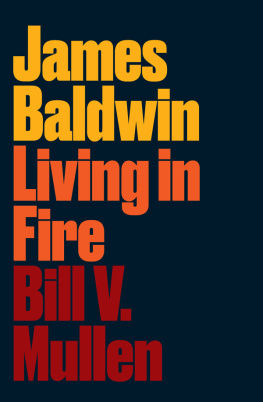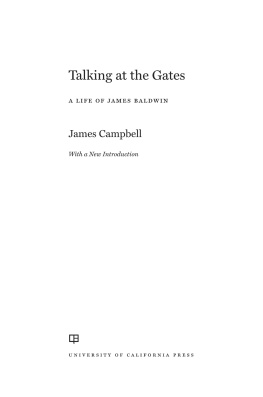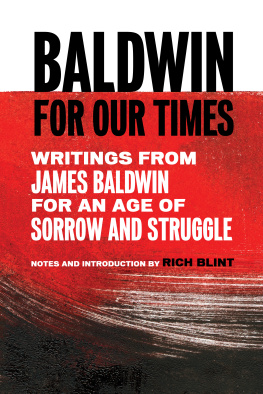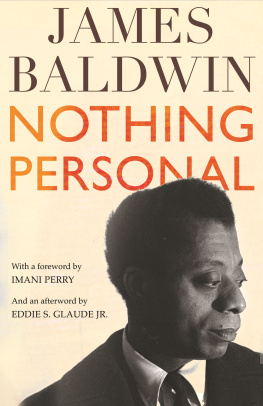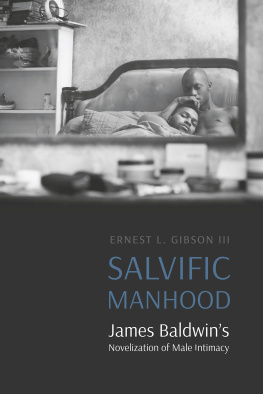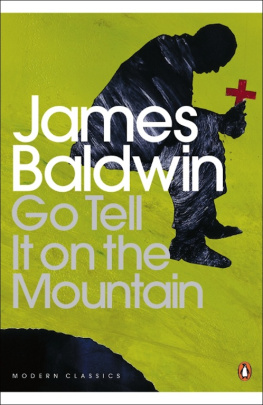Contents
Guide
James Baldwin
James Baldwin
Living in Fire
Bill V. Mullen

For Max and Shayari
First published 2019 by Pluto Press
345 Archway Road, London N6 5AA
www.plutobooks.com
Copyright Bill V. Mullen 2019
The right of Bill V. Mullen to be identified as the author of this work has been asserted by him in accordance with the Copyright, Designs and Patents Act 1988.
Every effort has been made to trace copyright holders and to obtain their permission for the use of copyright material in this book. The publisher apologises for any errors or omissions in this respect and would be grateful if notified of any corrections that should be incorporated in future reprints or editions.
British Library Cataloguing in Publication Data
A catalogue record for this book is available from the British Library
ISBN 978 0 7453 3854 5 Hardback
ISBN 978 1 7868 0496 9 PDF eBook
ISBN 978 1 7868 0498 3 Kindle eBook
ISBN 978 1 7868 0497 6 EPUB eBook
This book is printed on paper suitable for recycling and made from fully managed and sustained forest sources. Logging, pulping and manufacturing processes are expected to conform to the environmental standards of the country of origin.
Typeset by Stanford DTP Services, Northampton, England
Simultaneously printed in the United Kingdom and United States of America
Contents
Illustrations
James Baldwin in 1955, the year of publication of his essay collection Notes of a Native Son.
Baldwin with his friend, actor Marlon Brando, at the 1963 March on Washington.
Baldwin lecturing in Amsterdam, 1984.
Baldwin in Hyde Park, London, 1968.
Baldwin on a 1974 speaking tour in Amsterdam, here promoting a Dutch translation of his novel If Beale Street Could Talk. In 2018 Director Barry Jenkins (Moonlight) adopted the novel for film.
Baldwin demonstrated an interest in anarchism in the 1940s. He subscribed to both Why?, a U.S.-based anarchist periodical, and War Commentary, an anarchist publication produced in the United Kingdom. He likely attended anarchist meetings in New York before leaving the U.S. for Paris in 1948.
Baldwin described himself as a socialist and a Trotskyite for a brief time during the 1940s. He subscribed at least temporarily to Challenge!, the newspaper of the Young Peoples Socialist League, which he claimed to have joined. This issue from his personal archive is dated 1944.
Baldwin struggled to make ends meet after graduating high school. In 1944, he worked temporarily for both the U.S. Postal Service, and the Office of War Information. These 1944 government tax forms show him earning a total of $47.25 in the former job and $125.00 in the latter.
Baldwins dear friend, mentor and muse Beauford Delaney, a model for Baldwin of what the Black artist could be, painted this portrait of Baldwin around 1957.
Letter sent to Mary Painter by Baldwin, from the A.G. Gaston Motel, one of the few Black-owned hotels in the South, and thus something of a refuge.
A page from the manuscript for Another Country including the handwritten inscription, Marys Copy.
81 Horatio Street in Greenwich Village. Baldwin wrote parts of his novel Another Country here.
In 2015, the Greenwich Village Society for Historic Preservation dedicated this plaque to Baldwins time lived at this Horatio Street address.
Baldwin in Hyde Park, London.
In 2014, New York designated 128th Street between Madison Avenue and Fifth Avenue James Baldwin place.
Public school, P.S. 124, on 128th street in Harlem, attended by Baldwin.
The house in St. Paul de Vence in southern France Baldwin purchased in 1971. Baldwin spent much of his later years there, and died there in 1987.
Preface
James BaldwinA Revolutionary
For Our Time
You are talking to a man who lives in fire. What you have to understand is that people who are living in fire, have no sympathy with them who are afraid of the fire.
James Baldwin, television interview, 1972
[L]ove between men predicates not only the inevitable suffering but the very real possibility of becoming absolutely bankrupt.
James Baldwin, letter to Mary Garin-Painter, 1956
The only hope this country has is to turn overnight into a revolutionary country, and I say revolutionary in the most serious sense of that word: to undermine the standards by which the middle-class American lives.
James Baldwin, speech at the Liberation Committee for Africa, 1961
James Baldwin was born in Harlem, New Yorks vital, turbulent black Mecca, in 1924. His school teacher, Orilla Miller, said the Baldwin family home embodied the worst poverty that she ever saw.her son James matched only by the hardship she endured raising himand laterhis eight siblings.
In many ways Baldwins life was an attempt to both transcend this fire, and carry it with him. His first of six novels, Go Tell It On the Mountain, is based closely on events in his Harlem youth. One of his first major essays, The Harlem Ghetto, published in 1948 when he was all of 24, was a searing dissection of the grotesque social conditions that produced himself, and many, many African-Americans like him. Baldwin knew that escaping Harlem made him an exceptionfor every one of me, he wrote, there were thousands of young black boys dead, in prison, or on the needleand created two roles for him as an American writer: as survivor and witness. In this Baldwin conjoined himself to a long history of African-American protest writing dating to the American slave narrative, which seeks to describe oppression and economic subjugation for readers in a world outside that system. This capacity, which Baldwin called truth-telling, or disturbing the peace, was also fundamental to the development of a political self that showed no patience for oppression or the oppressor, and compelled him to turn rage into resistance. In a famous 1970 letter to his political sister, the revolutionary Angela Davis as she awaited trial in Marin County on false charges of murder, Baldwin wrote:
We know that we, the blacks, and not only we, the blacks, have been, and are, the victims of a system whose only fuel is greed, whose only god is profit. We know that the fruits of this system have been ignorance, despair, and death, and we know that the system is doomed because the world can no longer afford itif, indeed, it ever could have. And we know that, for the perpetuation of this system, we have all been mercilessly brutalized, and have been told nothing but lies, lies about ourselves and our kinsmen and our past, and about love, life, and death, so that both soul and body have been bound in hell.
The enormous revolution in black consciousness which has occurred in your generation, my dear sister, means the beginning or the end of America. Some of us, white and black, know how great a price has already been paid to bring into existence a new consciousness, a new people, an unprecedented nation. If we know, and do nothing, we are worse than the murderers hired in our name.
This passage encapsulates for Baldwin what it means to live in fire, and to relentlessly rage against those who made him burn. It is no accident that his most famous work of social protest is titled The Fire Next Time, and his most famous metaphor for America a burning house.

